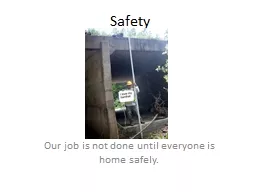

Topics First AidCPR Vehicles Job Hazard Analysis JHA Personal protective equipment PPE Check in check out Top 5 Hazards Topic 1 First AidCPR Take the training seriously What will you do if ID: 930644
Download Presentation The PPT/PDF document "Safety Our job is not done until everyon..." is the property of its rightful owner. Permission is granted to download and print the materials on this web site for personal, non-commercial use only, and to display it on your personal computer provided you do not modify the materials and that you retain all copyright notices contained in the materials. By downloading content from our website, you accept the terms of this agreement.
Slide1
Safety
Our job is not done until everyone is home safely.
Slide2Topics
First Aid/CPR
Vehicles
Job Hazard Analysis (JHA)
Personal protective equipment (PPE)
Check in / check out
Top 5 Hazards
Slide3Topic 1: First Aid/CPR
Take the training seriouslyWhat will you do if…
A crew member slips and breaks an ankle miles from the truck?
You bump into a hornets nest while electrofishing?
Slide4Topic 2: Vehicles
Driving; it’s the most dangerous thing we doThis topic is so important, it has it’s own presentation: ‘Fleet Orientation’
Slide5Topic 3: JHA
(Job Hazard Analysis)Before going in field
Know your limitations
Know your equipment
Know your environment
Get local input
Tailgate safety meetings weekly
or as issues arise
Slide6Topic 4: PPE
(Personal Protective Equipment)Stream Habitat
Hardhat, wading boots
(felt or sticky rubber)
Electrofishing
Hardhat,
wading boots
(felt or sticky
rubber)
, waders, rubber gloves
Long pants required under breathable waders
Hiking
Hardhat, hiking boots
(high enough to provide ankle support)
Slide7Other good PPE’s
SunscreenWeather appropriate clothesWater bottle
Rain gear
Never, ever work alone
Slide8Check in / Check out
Daily planNotify project contact whenDeparting for field
Including who is going where
Returning from field
Multiple crews; a person on each crew should know where other crews are going that day
SPOT devices
A one-way communication device for use when there is no cell reception
Not a substitute for a plan
Know where the nearest hospital is
Slide9Top 5 hazards
Driving
It is the most dangerous thing we do, period.
Wading
Slips = broken bones, separated joints
Plants & critters
Poison ivy, wasps, chiggers, ticks, snakes, bears
Exposure
wet & cold; hot & thirsty; sunny & burnt
Fatigue
Physical breakdown, loss of mental focus
Slide10Other hazards
WeatherLightningFlash floods
People
Landowners
Pot
Meth
Slide11People
Be aware of your surroundingsBe alert
and conscious of your personal and organizational safety at all
times
Follow
your instincts, if you see something that appears unusual, or hear anything that causes concern notify your supervisor
immediately
Slide12People
Openly hostile or threatening
Apologize and leave immediately, do not argue
Report to District office and your supervisor
Alert your team at tailgate safety meeting next day
Irritated
Forest Service manages a lot of land for a lot of different users
Your input is important to the Forest Service
Consider contacting your local District office to share your opinion
Provide a local contact
Interested
Share what you are doing
Provide a local contact for follow up
Slide13Lessons learned
Share a story of an accident or near-miss that will improve our safetyWhat happened?How can we change to avoid this in the future?
Not looking to place blame, but to learn and improve our safety program
No issue too small!
Slide14Slide15Slide16Questions?